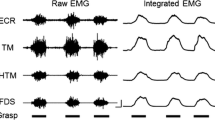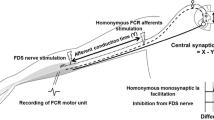We investigated characteristics of the F-waves in the upper limbs of patients suffering from primary torsion dystonia (PTD) by means of surface-electrode electromyography. Single electric stimulation was used to obtain optimum M-responses from the m. abductor pollicis brevis (median nerve) and m. abductor digiti minimi (ulnar nerve). Ten consecutive supramaximum electrical stimuli were applied to each nerve to obtain F-waves from the wrist. In general, the registered M-response latencies and amplitudes, as well as conduction velocities via all inspected nerves, demonstrated no significant deviations from the normal ranges. Nearly all investigated patients, except one, had normal F-wave minimal latencies. The mean amplitudes of F-waves from both median and ulnar nerves were higher than the average F-wave amplitudes described in the literature. The frequency of occurrence of F-waves in both median and ulnar nerves was greater than in the norm. According to our results, it can be concluded that the amplitude and, to some extent, frequency rather than the latency of F-waves are important in the studies of patients with PTD. Increased amplitudes and frequencies reveal changes in the excitability of alpha motoneurons, which could be accepted as a measure of a disturbed interneuronal balance probably caused by alterations in the suprasegmental control mechanisms related to PTD.
Similar content being viewed by others
References
J. Jankovic and S. Fahn, “Dystonic disorders,” in: Parkinson’s Disease and Movement Disorders, J. Jankovic, E. Tolosa (eds.), Lippincott, Williams and Wilkins (2002), pp. 331-351.
T. Warner, “Dystonia,” in: Birmingham Movement Disorders Course, Mov. Disord. Soc., (2008), pp. 267-279.
A. Albanese, M. P. Barnes, K. P. Bhatia, et al., “A systematic review on the diagnosis and treatment of primary (idiopathic) dystonia and dystonia plus syndromes: report of an EFNS/MDS-ES Task Force,” Eur. J. Neurol., 13, No. 5, 433-444 (2006).
M. A. Fisher, “Are H reflexes and F responses equally sensitive to changes in motoneuronal excitability?” Muscle Nerve, 19, No. 10, 1345-1346 (1996).
M. A. Fisher, “H reflexes and F waves: physiology and clinical indications,” Muscle Nerve, 15, No. 11, 1223-1233 (1992).
M. G. Espiritu, C. S. Lin, and D. Burke, “Motoneuron excitability and the F wave,” Muscle Nerve, 27, No. 6, 720-727 (2003).
B. Ishpekova, I. Milanov, and L. Hristova, Clinical Electromyography [in Bulgarian], Unison Art, Sofia (2003).
J. Кimura, Electrodiagnosis in Diseases of Nerve and Muscle. Principles and Practice, Edit. 3, Oxford Univ. Press (2001).
H. Matsumoto and Y. Ugawa, “Clinical signs, neurophysiological evaluation, and medication of spasticity - review,” Brain Nerve, 60, No. 12, 1409-1414 (2008).
B. Fierro, D. Raimondo, and A. Modica, “Analysis of F response in upper motoneurone lesions,” Acta Neurol. Scand., 82, No. 5, 329-334 (1990).
M. A. Fisher, “The contemporary role of F-wave studies. F-wave studies: clinical utility,” Muscle Nerve, 21, No. 8, 1098-1101 (1998).
K. Wohlfarth, M. Schubert, B. Rothe, et al., “Remote F-wave changes after local botulinum toxin application,” Clin. Neurophysiol., 112, No. 4, 636-640 (2001).
J. Dressnandt, C. Auer, and B. Conrad, “Influence of baclofen upon the alpha-motoneurons in spasticity by means of F-wave analysis,” Muscle Nerve, 18, No. 1, 103-107 (1995).
I. Milanov, “Mechanisms of baclofen action on spasticity,” Acta Neurol. Scand., 85, 305-310 (1992)
I. Milanov, “Mechanisms of tetrazepam action on spasticity,” Acta Neurol. Belg., 85, No. 5, 305-310 (1992).
I. Milanov and D. Georgiev, “Mechanisms of tizanidine action on spasticity,” Acta Neurol. Scand., 89, No. 4, 274-279 (1994).
Author information
Authors and Affiliations
Corresponding author
Rights and permissions
About this article
Cite this article
Semerdjieva, N., Atanasova, D., Hranov, G. et al. F-Wave in the Upper Extremities of Patients with Primary Torsion Dystonia. Neurophysiology 47, 244–247 (2015). https://doi.org/10.1007/s11062-015-9528-8
Received:
Published:
Issue Date:
DOI: https://doi.org/10.1007/s11062-015-9528-8




